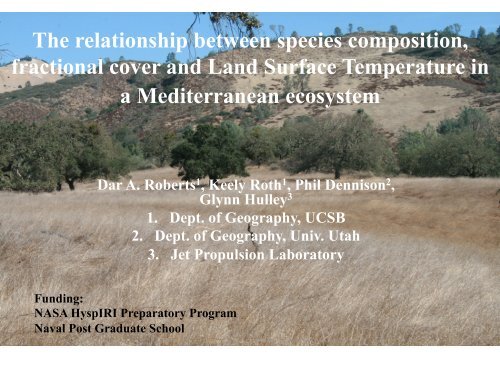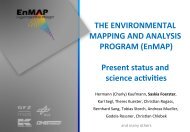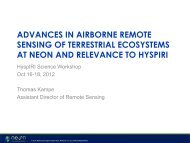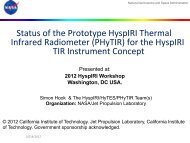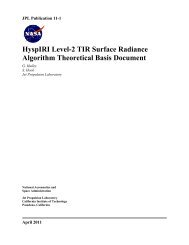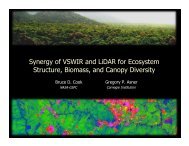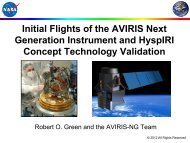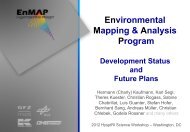Class - NASA
Class - NASA
Class - NASA
Create successful ePaper yourself
Turn your PDF publications into a flip-book with our unique Google optimized e-Paper software.
The relationship between species composition,<br />
fractional cover and Land Surface Temperature in<br />
a Mediterranean ecosystem<br />
Dar A. Roberts 1 , Keely Roth 1 , Phil Dennison 2 ,<br />
Glynn Hulley 3<br />
1. Dept. of Geography, UCSB<br />
2. Dept. of Geography, Univ. Utah<br />
3. Jet Propulsion Laboratory<br />
Funding:<br />
<strong>NASA</strong> HyspIRI Preparatory Program<br />
Naval Post Graduate School
• Introduction<br />
• Research Objectives<br />
• Study Site<br />
• Methods<br />
– Preprocessing<br />
– MESMA<br />
• Results<br />
• Conclusions<br />
Outline
Introduction<br />
• Numerous Synergies exist between the VSWIR and TIR<br />
• VSWIR<br />
– Species composition<br />
– Fractional cover<br />
– Canopy structure (LAI)<br />
0.7<br />
0.6<br />
Anth Water Ligno-‐cellulose<br />
– Canopy chemistry<br />
0.5<br />
– Photosynthetic function 0.4 Car<br />
• TIR<br />
0.3<br />
Chl<br />
– Temperature<br />
• Stress measure<br />
0.2<br />
AcerLf<br />
Acerlit<br />
• Evapotranspiration 0.1<br />
Betula<br />
– Emissivity<br />
0<br />
Fagus<br />
• Species composition<br />
350 850 1350 1850 2350<br />
• Canopy chemistry<br />
Wavelength (nm)<br />
• HyspIRI will enable those synergies to be fully explored<br />
and utilized<br />
Reflectance
Research Objectives<br />
• Explore synergies between the VSWIR and TIR<br />
using AVIRIS-MASTER pairs<br />
• Research Questions<br />
– What is the relationship between species composition<br />
and land surface temperature (LST)?<br />
– What is the relationship between fractional cover and<br />
LST?
Study Site (1)
Study Site (2)
Methods: Pre-Processing<br />
• AVIRIS: ATCOR Surface Reflectance<br />
– Scene parameters (sensor height, location, time)<br />
– ATCOR parameters<br />
• rural, 940&1130 nm water vapor<br />
• Scan angle from GLT<br />
• Visibility 80km (default), minor adjacency correction<br />
• MASTER<br />
– JPL MASTER TES online tool<br />
– Varied CO 2 , Ozone, Water vapor<br />
• Tuned using emissivity from Lake Lagunita<br />
• Ozone: 0.5, CO 2 : 370 ppm: Water vapor: 0.8 g (cm)<br />
– Temperature (K), Emissivity (5 bands)<br />
• Both: Georectified (7.5m AVIRIS or 15 m. MASTER) to a<br />
spatially degraded DOQQ (2010)<br />
– Resampled nearest neighbor using Delaney Triangulation
Training/Validation Spectra<br />
• Sampled 23 land-cover/species from 307 polygons<br />
• Random training/validation (10 max, or 50%)<br />
• Three pulls, first pull acceptable (Roth et al., 2012)
Multiple Endmember Spectral Mixture<br />
Analysis (MESMA)<br />
Complexity: 3,2,1 RGB <strong>Class</strong> Composition: NPV-GV-Soil<br />
• Number and types of em varies per pixel<br />
RGB<br />
• Optimum model and complexity level based on RMS<br />
– 2 em =classified map<br />
• Complexity level selected using RMS change threshold<br />
– 0.007
Endmember Selection: Forced Iterative<br />
Endmember Selection<br />
• Traditional: EAR/<br />
MASA/COB<br />
• Automated: Iterative<br />
Endmember Selection<br />
(IES) (Schaaf/Roth)<br />
• Forced IES<br />
– Injects EMC optimal ems<br />
into IES for weak or<br />
missing classes<br />
– Continues until Kappa<br />
does not improve<br />
– Final library can be cut<br />
off at any number<br />
• 101<br />
Kappa Coefficient<br />
0.8<br />
0.7<br />
0.6<br />
0.5<br />
0.4<br />
0.3<br />
0.2<br />
0.1<br />
0<br />
Injection<br />
Cut off<br />
0 50 100 150 200 250 300 350 400<br />
Number of Endmembers<br />
See Roth et al., 2012
• 2em classification<br />
– 101 endmembers<br />
• 67 GV<br />
• 11 GV-NPV (can be either)<br />
• 3 Rock<br />
• 7 Soil<br />
• 13 urban<br />
• GV<br />
– No mixtures, reduced<br />
redundancy<br />
– 25 endmembers<br />
– 1 to 3 per species<br />
• NPV<br />
– 7 endmembers<br />
– 3 Arcasale, 2 brni, 2 magf<br />
Endmember Spectra
• Soil/Rock<br />
– 8 endmembers<br />
– 2 rocks<br />
– 6 soils<br />
• Impervious/urban<br />
– 10 endmembers<br />
– 2 roads<br />
– 3 tile roofs<br />
– 4 composite roofs<br />
– 1 painted roof<br />
Endmember Spectra
Results: <strong>Class</strong>ification<br />
• Model 101: Kappa 0.555, Overall 56%<br />
• Excellent (> 85%: Green): ARCA-SALE, CISP, ERFA, MAGF, PEAM<br />
• Very good(> 60%: Orange): ADFA, BAPI, CEME, QUAG, SOIL, Urban<br />
• Poor (< 30%: Red): CESP, PISA, UMCA
Results: <strong>Class</strong>ification<br />
• The map is better than the validation suggests<br />
• All but a few classes (PISA, UMCA) are generally correct, BAPI is overmapped<br />
• Polygon Accuracy based on most abundant: 84.7%
<strong>Class</strong> vs Composition: North<br />
• <strong>Class</strong><br />
– ARCASALE<br />
– MAGF<br />
– ERFA<br />
– Lesser ADFA, QUDO/QUAG<br />
– Unclassified (bright MAGF, SOILS)<br />
• Composition<br />
– High GV: QUDO/QUAG (in valleys)<br />
– Mixed GV/NPV: ARCASALE/ERFA<br />
– High NPV: MAGF/BRNI?
<strong>Class</strong> vs Temperature: North<br />
• <strong>Class</strong><br />
– ARCASALE<br />
– MAGF<br />
– ERFA<br />
– Lesser ADFA, QUDO/QUAG<br />
– Unclassified (bright MAGF, SOILS)<br />
• Temperature<br />
– Cool: QUDO/QUAG (in valleys)<br />
– Warm ARCASALE/ERFA<br />
– Hot: MAGF, Soils
<strong>Class</strong> vs Composition: Central<br />
• <strong>Class</strong><br />
– ADFA<br />
– QUDO<br />
– QUAG<br />
– CEME, CECU, CESP<br />
– Rock/Soil<br />
– MAGF<br />
• Composition<br />
– High GV: All but MAGF and River channel<br />
– Mixed GV/NPV: ADFA, BAPI (higher NPV-<br />
probably something else)<br />
– High NPV: MAGF<br />
– High Rock/Soil; River channel
<strong>Class</strong> vs Temperature: Central<br />
• <strong>Class</strong><br />
– ADFA<br />
– QUAG, some QUDO<br />
– CEME, CECU, CESP<br />
– Rock/Soil<br />
– MAGF<br />
• Composition<br />
– Cold: North facing slope, dominated by trees<br />
(QUAG)<br />
– Cool: South facing slopes, flat terrain<br />
dominated by shrubs (ADFA, Ceanothus<br />
– Hot: Bare rock on ridges, river channels,<br />
MAGF
<strong>Class</strong> vs Composition: South<br />
• <strong>Class</strong><br />
– MAGF<br />
– BRNI<br />
– EUSP<br />
– PEAM<br />
– CISP<br />
– BAPI<br />
– Urban/Soil<br />
– Minor Marsh<br />
• Composition<br />
– High GV: PEAM, CISP, EUSP<br />
– Mixed NPV-GV: BAPI<br />
– High NPV: MAGF, BRNI<br />
– High soils/Impervious: Urban
<strong>Class</strong> vs Temperature: South<br />
• <strong>Class</strong><br />
– MAGF<br />
– BRNI<br />
– EUSP<br />
– PEAM<br />
– CISP<br />
– BAPI<br />
– Urban/Soil<br />
– Minor Marsh<br />
• Temperature<br />
– Cold: EUSP<br />
– Cool: PEAM, CISP<br />
– Warm: BAPI, BRNI<br />
– Hot: MAGF, Urban
GV Fraction<br />
1<br />
0.8<br />
0.6<br />
0.4<br />
0.2<br />
Temperature Compositional<br />
0<br />
y = -0.0404x + 13.036<br />
R² = 0.589<br />
-0.2<br />
300 305 310<br />
Temperature<br />
315<br />
(K)<br />
320 325 330<br />
Relationships<br />
• GV fraction strongly inversely correlated with temperature for<br />
vegetated targets<br />
• Shade fraction poorly correlated (high shade, cooler, r 2 =0.04)<br />
– Shade is not just shadows, but also varies with albedo and local zenith<br />
Shade Fraction<br />
0.5<br />
0.4<br />
0.3<br />
0.2<br />
0.1<br />
0<br />
-0.1<br />
-0.2<br />
-0.3<br />
300 305 310<br />
Temperature<br />
315<br />
(K)<br />
320 325 330
GV Fraction<br />
1<br />
0.8<br />
0.6<br />
0.4<br />
0.2<br />
0<br />
Temperature Species Relationships<br />
-0.2<br />
300 305 310<br />
Temperature<br />
315 320<br />
(K)<br />
325 330 335<br />
adfa arcasale argl bapi brni<br />
cecu cesp cisp erfa eusp<br />
irgr mafg marsh peam pisa<br />
plra quag qudo umca<br />
• Species composition strongly impacts<br />
temperature, significant clustering<br />
• Trees (circles)<br />
– Coolest, high to moderate GV<br />
• Evergreen shrubs (diamonds)<br />
– Warmer, high to moderate GV<br />
• Deciduous shrubs (triangles)<br />
– Warm, moderate to low GV<br />
• Forbs/grasses (squares)<br />
– High to low GV, warm to hot
Conclusions<br />
• MESMA was capable of mapping 23 species/landcover classes at<br />
reasonable accuracies<br />
– Other classifiers can do better (i.e., LDA/CDA)<br />
• Plant species map out correctly in geographic space<br />
• GV and temperature are inversely correlated<br />
• Plant species cluster uniquely in compositional temperature<br />
space, likely resulting from functional differences<br />
– (e.g., deeply rooted, evapotranspiring cool trees vs shallow rooted<br />
partially senesced shrubs)<br />
• More is coming<br />
– LDA species maps<br />
– EWT – emissivity<br />
– Water vapor TES<br />
– Full range spectroscopy<br />
– And HyspIRI!


